Rapé: The Sacred Shamanic Snuff of the Amazon
What is rapé?
Rapé (pronounced Hapé) is a sacred shamanic snuff traditionally used by various Indigenous tribes in Brazil. This fine powder is made from a powerful blend of mapacho (Nicotiana rustica, a potent Amazonian tobacco distinct from common cigarette tobacco), plant-based ashes, and other medicinal and spiritual herbs. Deeply woven into ceremonial life, rapé combines physical and energetic cleansing, offering both medicinal benefits and spiritual alignment.
(Note: In Portuguese, the “R” at the beginning of a word is pronounced like an “H”, hence the rapé pronunciation “Hapé.”)
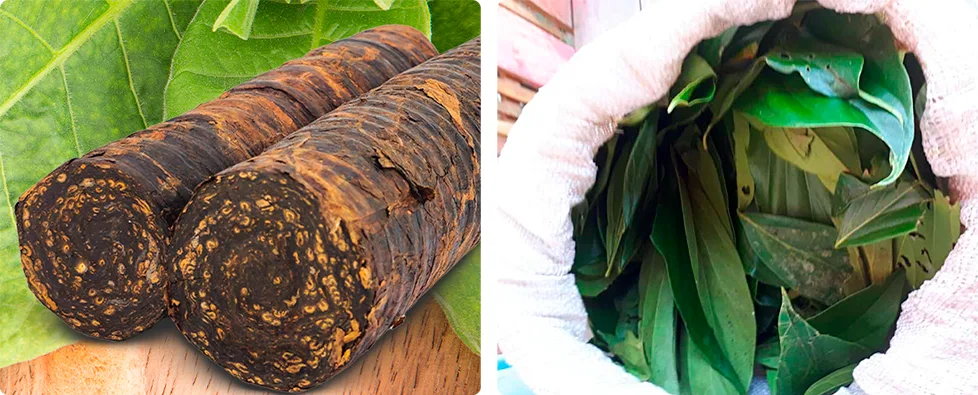
The ritual of preparing rapé is a sacred and intentional process, carried out by experienced shamans or tribal elders with deep knowledge of each ingredient. Creating a rapé blend requires time, skill, spiritual alignment, and gratitude, as every step of the process is treated as an offering — not just a task.
While the base of rapé is typically mapacho (Nicotiana rustica), the final blend often includes alkaline ashes from specific medicinal trees, aromatic herbs, tonka beans, scented leaves, and other sacred plant allies. Each rapé recipe is unique, often passed down through generations within the tribe, and carefully crafted according to the ceremony’s purpose or healing intention. Ingredients may be chosen for their spiritual properties, medicinal benefits, or even their aroma and energetic influence.
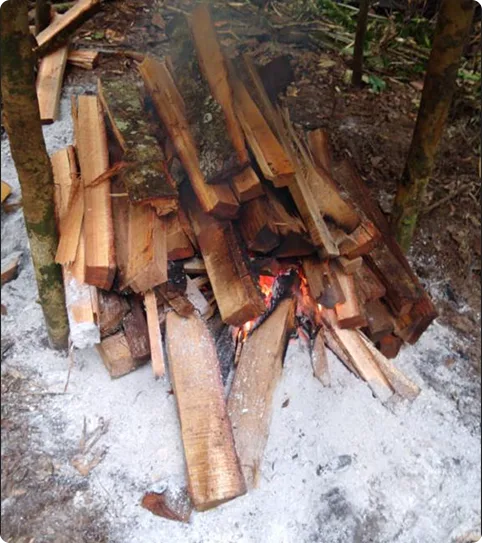
The Strength of Rapé: What Determines Its Potency?
The strength of a rapé blend can vary significantly and is influenced by several key factors — especially the type of tobacco, the ratio of tobacco to ashes, and the specific plants or trees used to make the ashes.
The primary tobacco used in traditional rapé is mapacho (Nicotiana rustica), a wild Amazonian tobacco known for its high nicotine content and powerful energetic properties. Some blends use a stronger mapacho strain, while others may use a milder one, directly impacting the overall potency of the snuff.
The balance between tobacco and ash also plays a crucial role. In general, higher tobacco content results in a stronger, more intense rapé, while blends with a higher percentage of ash tend to be more alkaline, cleansing, and subtle in their effect. Some ceremonial rapés are almost entirely ash-based for specific energetic work, while others lean heavily on the grounding, focusing effects of strong tobacco.
Additionally, the type of ash used is not merely filler — it significantly contributes to the experience. Ashes made from trees like Tsunu, Mulateiro, Murici, or Pau Pereira each bring different spiritual and medicinal qualities, as well as different intensities and textures to the blend. For example, Tsunu ash is known for its clarity and sharpness, while Murici ash offers a more earthy, stabilizing experience.
Some rapé blends are even tobacco-free, created using only powdered herbs and ashes. While these are typically used for lighter energetic work, grounding, or children’s ceremonies, they do not carry the same depth of cleansing, focus, or spiritual force as blends made with Nicotiana rustica.
Because of these variables, rapé can range from gentle and soothing to intense and deeply purgative, and choosing the right blend depends on the user’s intention, sensitivity, and the ceremonial context.
What is the origin of snuff?
What is rapé used for?
Rapé plays a central role in the ceremonial, spiritual, and medicinal practices of numerous Indigenous tribes across South America. Far from being a casual or recreational substance, this sacred shamanic snuff is approached with deep reverence — its use guided by a profound understanding of both physical healing and the ethereal, energetic dimensions it touches during ceremony.
Because rapé blends can contain a wide variety of plant ashes, herbs, and aromatic elements, and because every user brings their own intention into the ritual, the purposes for using rapé are incredibly diverse. Some of the most common intentions include:
- 🌬 Energetic cleansing and clearing of negative thoughts or stagnant emotions
- 🌿 Supporting the immune system and clearing the sinuses or lungs
- 👁 Facilitating visionary states, insight, and inner guidance
- 🌎 Deepening connection to nature, the Earth, and one’s own spirit
- 🤲 Strengthening group unity and energetic alignment during collective ceremonies
- 🌀 Assisting with the release of trauma, emotional blockages, or energetic cords
- 💡 Enhancing mental clarity, focus, and intention
- 🌱 Addressing certain digestive, respiratory, or nervous system issues
- 🔮 Opening the way for prayer, meditation, or communication with spiritual allies
Each rapé ritual is as unique as the blend itself. The energetic tone and outcome are influenced by the user’s spiritual readiness, the quality and composition of the snuff, and the ceremonial container — whether it’s a personal daily ritual or part of a group ceremony led by a pajé (shaman or medicine person).
The frequency of rapé use also varies widely depending on the tradition. Some tribes use it daily as a spiritual hygiene practice, while others reserve it for special healing sessions, plant diets, or communal rites. In either case, rapé is never used casually. It is a sacred tool, meant to align, awaken, and cleanse.
It’s important to highlight that sacred tobacco, especially when prepared as rapé, is radically different from the industrialized, addictive use of tobacco seen in mainstream society. In traditional contexts, tobacco is a master plant, a teacher, and one of the most respected spirit allies in the forest. The intelligent and intentional use of rapé is a world apart from the malpractice, dependency, and harm associated with commercial tobacco products and chain smoking.
In essence, rapé offers a multi-dimensional experience — it is medicine, ritual, teacher, and mirror. When used with respect, it becomes a bridge between the physical and spiritual worlds, helping individuals return to presence, purpose, and harmony with life.
Using rapé medicine
Medicinal rapé is primarily used to detoxify the body and support physical healing. One of its most notable effects is its ability to stimulate the release of excess mucus, helping to clear the respiratory system of toxins, bacteria, and other impurities. This powerful purging action makes rapé a valuable ally in cleansing the sinuses, lungs, and energetic pathways of the body.
In many Indigenous traditions, rapé is also recognized for its sanative and analgesic properties. Certain blends are used to support the treatment of infections, reduce pain and inflammation, and help relieve fatigue or physical exhaustion. When applied with care, it may even be used to cleanse wounds or support the body’s natural healing processes.
Due to the presence of nicotine from Nicotiana rustica (a potent, naturally occurring compound in sacred tobacco), rapé also has a direct effect on blood flow and brain chemistry. This can result in heightened mental clarity, improved focus, and enhanced alertness — which is why some practitioners turn to rapé before prayer, meditation, or tasks that require deep presence and concentration.
It’s common for people who are feeling physically run down, energetically blocked, emotionally overwhelmed, or spiritually disconnected to seek the support of shamanic rapé as part of their healing path. Used with intention, medicinal rapé can serve as a powerful reset for the body, mind, and spirit — clearing what no longer serves and creating space for renewal.
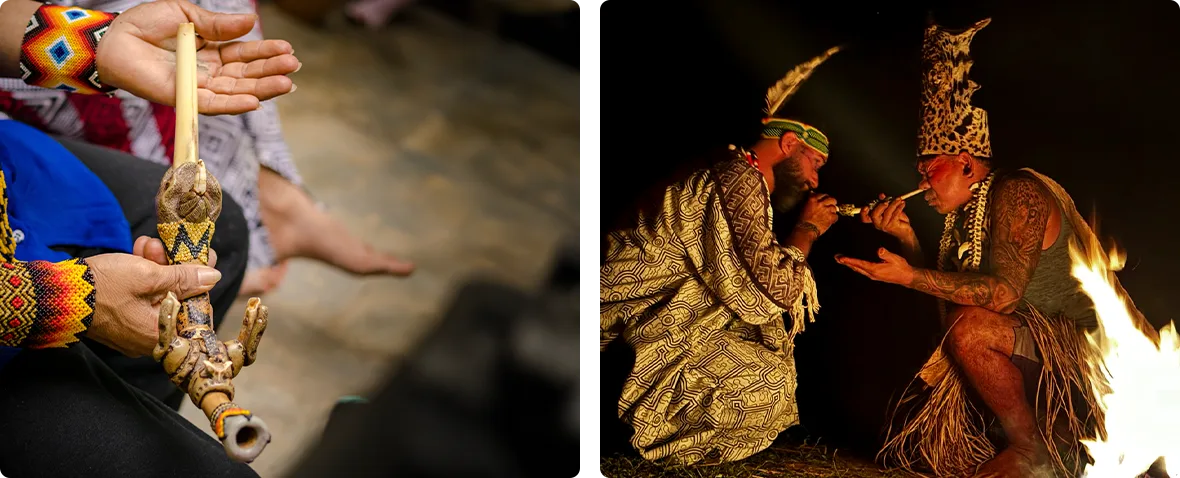
How Long Does Rapé Last?
One of the most common questions for new users is: How long does rapé last? The answer depends largely on the amount used, the strength of the blend, and the user’s sensitivity.
In general, the peak effects of rapé last anywhere from 5 to 15 minutes. This period is typically when the energetic clearing, physical sensations, and mental sharpening are most noticeable. During this time, users may experience increased clarity, emotional release, or deep introspection, depending on the intention and blend.
When larger doses are taken — especially by those new to rapé — the effects can last significantly longer, and may include intense purging, emotional processing, or dizziness. For this reason, it is always recommended to start with a small amount, allowing the body to adjust and the spirit of the medicine to work gently and respectfully.
Some of rapé’s subtler effects — like a sense of grounding, enhanced focus, or spiritual connection — may continue for hours after the ceremony, even once the initial sensations have faded.
As with all sacred plant medicines, listening to your body, working with intention, and approaching rapé with respect are key to receiving its full benefits.
How to Use Rapé: Ceremony, Intention, and Technique
Rapé is a sacred medicine used in ceremonial contexts by many Indigenous tribes of the Amazon, and it should always be approached with respect, awareness, and intention. This shamanic snuff is traditionally administered into the nostrils using specific pipes, and its use is often accompanied by other spiritual or healing practices. The process is both technical and energetic, and not simply about consuming a substance — it is about entering into relationship with a powerful plant spirit.
Before diving into the practical aspects of how to use rapé, it’s essential to understand the depth of cultural knowledge behind it. For many tribes, it takes years of apprenticeship for a shaman to learn how to prepare, administer, and guide ceremonies with rapé. Each step, from sourcing and grinding the plants to blowing the snuff, is done with prayer, reverence, and spiritual alignment.
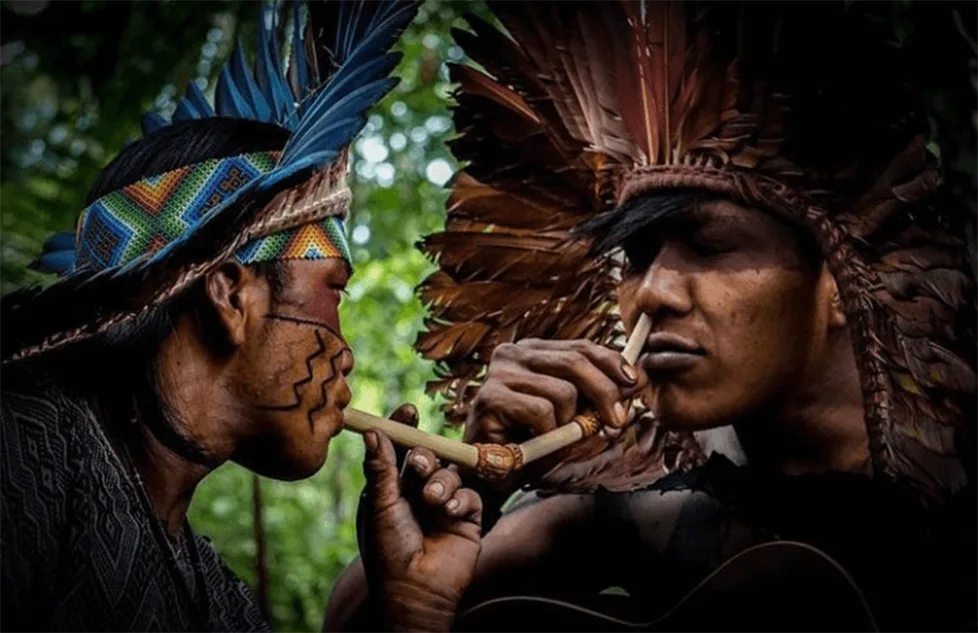
The Rapé Application Process
Rapé is not snorted, sniffed, or inhaled in the way some might assume. Instead, it is gently blown into the nostrils using a special pipe. The powder is extremely fine, traditionally prepared by pounding ingredients with mortar and pestle, then sifting it through cloth until the desired texture is achieved.
There are two main ways to apply rapé:
🔸 1. Tepi – The Sacred Blow from Another
In ceremonial settings or when working with a guide, rapé is typically administered with a tepi, a long blowpipe used to transfer the rapé from one person to another. The practitioner or shaman blows the powder into each nostril of the recipient, creating an immediate and powerful energetic shift. This transmission is considered a sacred act, often accompanied by chanting, prayer, or guidance.
🔸 2. Kuripe – Self-Application Pipe
Experienced users or those in solitary practice may use a kuripe, a V-shaped self-applicator that connects the mouth to the nose. The user loads a pea-sized amount of rapé into the pipe and blows it into one nostril, then repeats on the other side. Self-application is common in personal rituals or during plant dieta processes, where the practitioner works closely with their own energy field and intention.

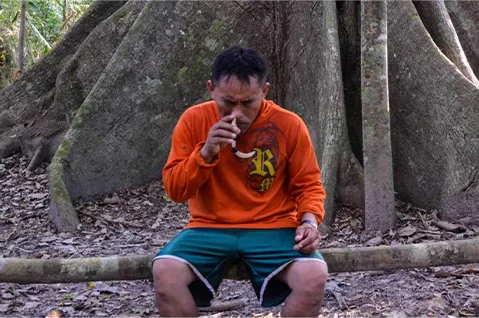
Important Tips for Using Rapé
- Start small: A small dose is enough, especially for newcomers. The medicine is strong and precise.
- Breathe with intention: After application, allow the rapé to settle. Try to hold it in briefly, and then let the natural purging process unfold.
- Always apply to both nostrils: This is symbolic and energetic — one side represents what you are releasing, the other what you are welcoming in. Applying to only one side can create imbalance in the ritual.
- Sit in stillness: Rapé works best in a grounded, meditative state. After application, close your eyes, breathe deeply, and listen.
- Approach with respect: This is not a recreational substance. Rapé is a sacred plant technology, and when used consciously, it becomes a powerful ally for healing, focus, and spiritual alignment.
Discover the brazilian tribes that make rapé
There is a multitude of Brazilian Indigenous tribes that traditionally use rapé snuff, each developing and passing down their own distinct blends and ceremonial practices from generation to generation. Among these are the Yawanawá, Apurinã, Kuntanawá, Huni Kuin, and Nukini, to name only a few. Not only do the ingredients and rituals vary between tribes, but even the preparation process is unique — from the techniques and tools used, to the selection of herbs, and even the sacred songs sung during the blending. Each of these elements contributes to the specific energetic signature of every rapé.
Types of Rapé: A Sacred Diversity of Tribal Wisdom
There is a wide variety of rapé snuffs, each as diverse and unique as the Indigenous tribes who prepare them. The name of a shamanic rapé blend usually reflects the tribe of origin, and sometimes includes the name of the shaman who created it or refers to key ingredients in the blend. There are tribal rapés, blended variations, ceremonial formulas, and even tobacco-free alternatives. Some are ideal for beginners, while others are more suited for experienced users. Blends may range from light to dark in color, depending on the specific herbs, ashes, and preparation methods used.
🌿 Yawanawá Tsunu Rapé
One of the most well-known blends, Yawanawá Tsunu is often considered a classic among ceremonial rapés. It is made from handmade mapacho tobacco cords (cordas) and ashes of the Tsunu tree bark. This blend is renowned for bringing spiritual strength, deep cleansing, and a warm, grounding energy. It is frequently used in rituals to clear stagnant energies and support physical and emotional healing.
🔥 Caboclo Paricá Rapé
Crafted by the Caboclo people, who carry mixed ancestry of Indigenous Brazilian and European roots, this blend reflects a fusion of cultural energies. The Caboclo Paricá contains strong Nicotiana rustica (mapacho) and ashes from the Paricá tree bark, also known as Xinshá. This rapé is known for its potency and force, making it more suitable for seasoned users seeking a powerful energetic reset.
🌸 Nukini White Rose Rapé
Representing feminine strength and nurturing energy, Nukini White Rose — is infused with floral elements used traditionally across Brazil in herbal baths and aura cleansing. While delicate in aroma and energy, it is also deeply grounding, offering both relaxation and protection. This rapé is ideal for those seeking a softer yet spiritually potent experience.
✨ Shawadawã Spiritual Rapé
For those called to deep ceremonial work, the Shawadawã Spiritual rapé is a profound tool. Created by the Shawadawã tribe, it includes Kapayuba herbs, known for amplifying spiritual vision and enhancing ceremony. This rapé is often used in conjunction with Ayahuasca, sacred songs, and guided healing work. It carries strong energetic intelligence, opening the mind and spirit for inner insight, alignment, and connection to the divine.
🍃 Apurinã Awiry (Green) Rapé
Exceptionally unique, the Apurinã Green Rapé stands apart for being completely tobacco-free — though trace amounts of nicotine may still be present in the plant material. This is not a blend in the traditional sense, but rather a pure powder made from the Awiry plant, a sacred species harvested by the Apurinã people during the dry season, when the river recedes and the plant becomes accessible. Its stunning green color, fresh aroma, and gentle potency offer a deeply clarifying and grounding experience, suitable for both ceremony and meditation.
Each rapé carries the spirit of the forest, the energy of the plants, and the intentions of the people who prepare it. Whether for healing, protection, awakening, or clarity, there is a rapé for every path — and each blend is a living expression of ancestral wisdom and sacred reciprocity.
Where to Buy Rapé: Sourcing with Integrity and Intention
Learning about rapé is only one part of the journey — the deeper transformation comes through direct experience, guided by respect, intention, and the spirit of the medicine. But just as important as how rapé is used is where it is sourced from.
When choosing to work with sacred shamanic snuff, it is essential to purchase rapé from a reputable, ethical, and transparent source — one that honors the Indigenous traditions behind it and actively supports the communities who carry this ancestral wisdom forward.
At Sacred Connection, we offer a carefully curated selection of authentic tribal rapé blends, each sourced directly from our partner communities across the Brazilian Amazon. Every product is made with reverence, prayer, and deep cultural integrity, and our work is rooted in direct relationships with tribes like the Yawanawá, Huni Kuin, Apurinã, Nukini, Shawadawã, and more.
By purchasing rapé from SacredConnection.co, you are not only receiving high-quality, ceremonial-grade medicine, but also contributing to:
- 🌱 The preservation of traditional knowledge
- 🤝 Fair trade partnerships with tribal artisans and shamans
- 🛖 Community-led projects, including agroforestry, food sovereignty, and spiritual education
- 🌍 A global movement of conscious reconnection with nature and spirit
We invite you to explore our collection and find the blend that resonates with your path. Whether you are beginning your journey or deepening an existing practice, we are here to walk with you.
🛒 Browse our full collection of sacred rapé blends at SacredConnection.co
What to Expect from the Rapé Experience: Physical and Spiritual Effects
When rapé is administered, its effects begin almost immediately. Physically, as the fine powder is blown into the nostrils, many users experience an intense burning sensation across the center of the face, often accompanied by watering eyes and a tingling or tensing feeling around the third eye and crown chakra. These are natural responses as the active ingredients interact with the mucous membranes and energetic centers.
A common initial reaction is sneezing, triggered by the stimulation of the nasal cavity. This leads to a cleansing of the sinuses, often followed by nasal discharge as excess mucus is expelled from the airways and the frontal head area. If the nasal or sinus passages are significantly blocked, this purging process may cause temporary headaches or difficulty breathing, which typically pass as the medicine takes effect.
In cases where the throat or chest are also congested, rapé may loosen deeper obstructions, sometimes leading to coughing, gagging, or even vomiting. While these effects may seem intense, they are considered a natural and necessary part of the detoxification process. In many tribal traditions, this purging is sacred — a release of physical, emotional, and spiritual toxins.
Despite the initial intensity, users often report that, by the end of the process, they feel calmer, more centered, and mentally clear. The ceremony brings a heightened connection to self, a deeper awareness of surroundings, and a renewed ability to perceive subtle energy and intention with greater precision.

Rapé as a Tool for Prayer, Focus, and Spiritual Alignment
Beyond the physical detoxification, rapé is a powerful spiritual tool — one that opens and aligns the energetic body. It is especially revered for its ability to amplify intentions, sharpen focus, and enhance prayer or meditation. Many practitioners use rapé to clear the mind, anchor their presence, and open channels of inner or higher communication.
This sacred snuff works in harmony with the user’s intentions. For this reason, it is vital to approach the ritual with clarity, humility, and presence. The energy present at the moment of intake — whether it be for protection, empowerment, release, or connection — will be carried into the ceremony and reflected back. Anything that is no longer serving the body or spirit will naturally begin to purge itself, whether through emotion, breath, or physical release.
Proper ceremonial preparation is also essential. In many traditions, this includes dietary restrictions, quiet contemplation, and a clear setting of purpose before the medicine is received. As a result, the experience becomes transformational, not just a ritual — a bridge between the seen and unseen.
A Unified Experience: Grounded and Awakened
Rapé brings balance. On a biochemical level, the presence of nicotine from Nicotiana rustica stimulates the release of neurotransmitters such as dopamine, acetylcholine, and epinephrine. This results in a state of calm alertness, where the user feels both relaxed and mentally present. It is not a jittery or anxious stimulation, but rather an energized sense of clarity — rooted, awake, and grounded.
This rare combination of physical purification and spiritual activation is what makes rapé such a revered medicine in Amazonian traditions. It is a tool for cleansing, awakening, and aligning — a medicine that works on the body, mind, and spirit, harmonizing all three through intentional use.
Whether for healing, focus, emotional release, or spiritual connection, rapé offers a unique and powerful way to reset, realign, and reawaken.
A Note on Tobacco: Use with Respect and Intention
While rapé is a sacred medicine traditionally used for spiritual alignment, healing, and focus, it is important to remember that it is also a tobacco-based product. The primary tobacco used in rapé is mapacho (Nicotiana rustica), a potent and unprocessed form of sacred tobacco used ceremonially in many Indigenous traditions.
Because of its nicotine content, rapé can be habit-forming if misused. It is not meant to be consumed casually or frequently without awareness. At Sacred Connection, we strongly encourage all users to treat rapé with respect, moderation, and clear intention — as a tool for meditation, clarity, and healing, not as a substitute for recreational tobacco or a source of stimulation.
In some cases, rapé has helped individuals reduce or quit cigarette smoking by offering a more conscious, ritual-based relationship with tobacco. However, this should always be approached mindfully and within a supportive context of harm reduction and spiritual growth.
🚨 Tobacco Warning: Rapé contains nicotine, which is a naturally occurring addictive substance. This product is intended for ceremonial and personal development purposes only, and should not be used as a recreational drug or habit-forming substance.
Is Rapé Legal?
Yes — Rapé (also known as shamanic snuff or rapé snuff) is legal in the United States, provided it contains no hallucinogenic substances or restricted psychoactive compounds. As long as the ingredients are limited to tobacco, plant ashes, and non-psychoactive herbs, rapé is considered a legal traditional tobacco product under U.S. regulations.
At Sacred Connection, we strictly comply with all national and international tobacco regulations. Our products are prepared and distributed with full transparency, care, and compliance, ensuring a safe and trustworthy experience for our customers and partners.
🛡️ You can order from Sacred Connection with confidence — our rapé is ethically sourced, legally imported, and handled with deep respect for both the law and the sacred traditions behind it.

